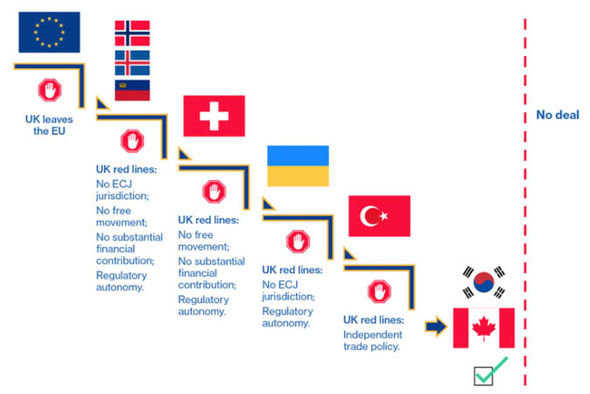##Second referendum in general
##Existing solutions seen in other countries
Since it's just instructing British politicians what to (try to) negotiate, they could just pick another country and try to get the same relation with the EU as they have. The Express uses this imagediagram:

###Speculation###On interpreting the diagram
The diagram illustrates existing arrangements between the EU and other countries. The more to the left in the diagram, the more integrated the country is with the EU and its policies. Being more to the right indicates a country less integrated with the EU.
The first option is being an EU member, which is the most integrated with the EU a country can be (this option is quite obvious). Underneath the EU flag it indicates a red line, which means that red line prevents this option from being feasible. Indeed, 'UK leaves EU' means it cannot also be a member of the EU.
The second option is a Norway-style deal. Norway is not a member of the EU, but it does accept ECJ jurisdiction, free movement of workers, substantial financial contributions and it does not have regulatory autonomy. If the UK does not accept one or more of these restrictions then the Norway-style deal is off the table.
The third option is the Swiss-style deal. This deal still requires free movement, a substantial financial contribution and does not allow for regulatory autonomy. The difference with the Norway-style deal is that there is no ECJ jurisdiction. Instead, there is another mechanism in place (this is quite complicated, this article by the Guardian touches on that).
Going further to the right, the options can be read in the same way. At the very right there is a line saying no deal. This means that if the UK does not accept any type of concession then a deal is not possible at all.
##Speculation on a second referendum
As Hedgehog points out, the contents of a (possible) second referendum are not clear (yet). In that answer, it's pointed out that a high-ranking Labour politician argues the result of the first referendum should be assumed. On the other hand, others within the Labour party have suggested not ruling out remain as an option.
